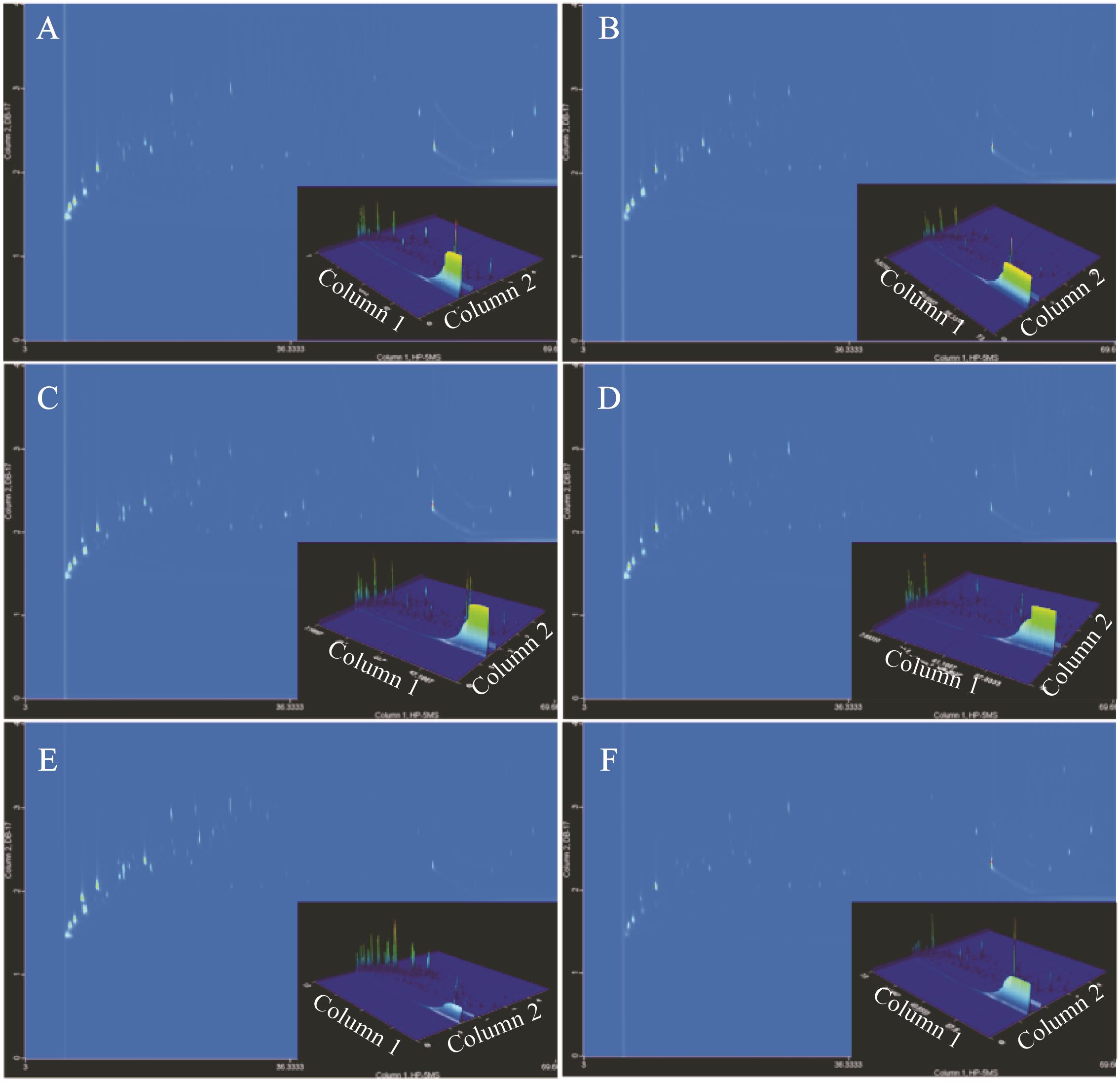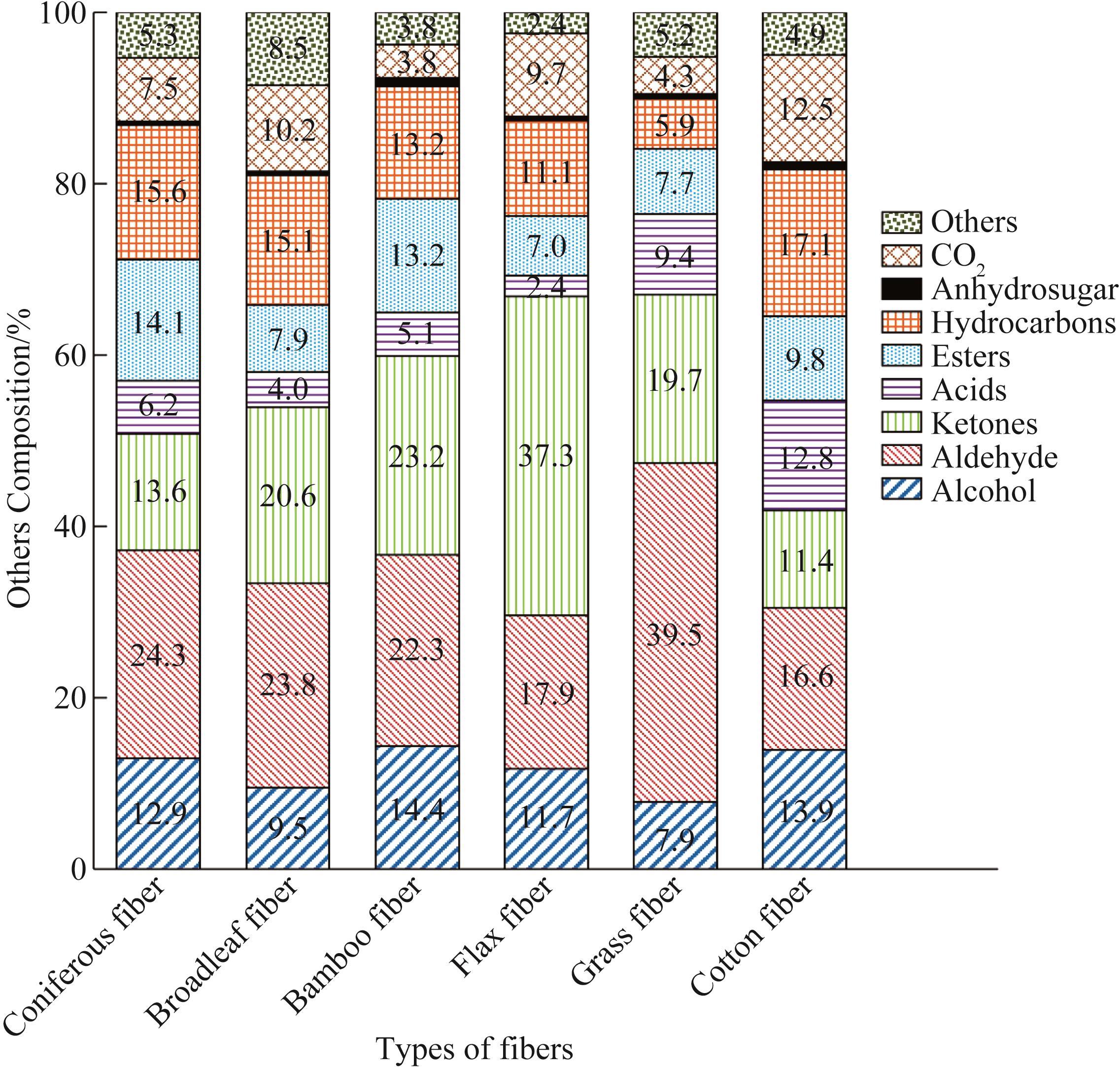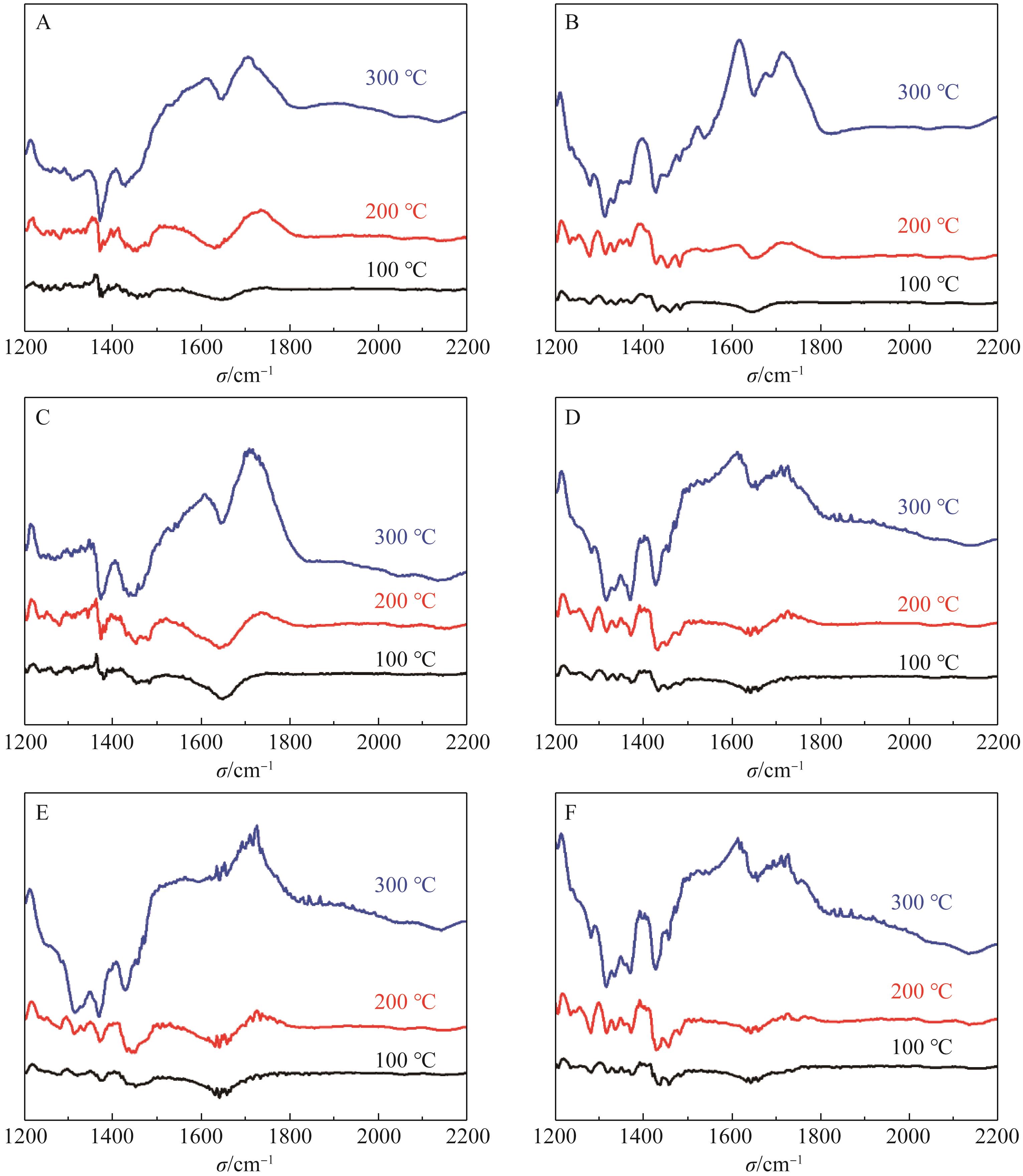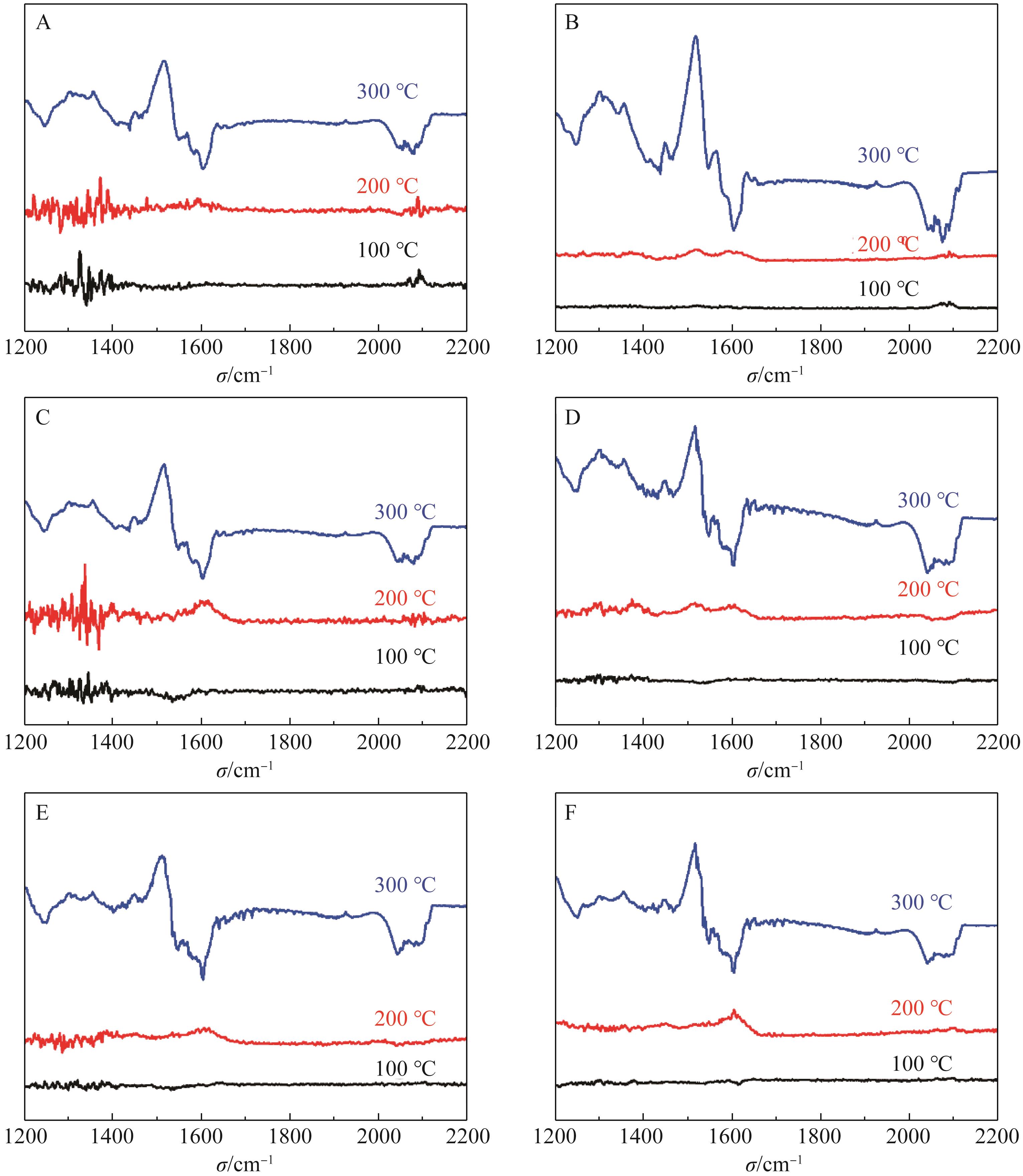
Chinese Journal of Applied Chemistry ›› 2022, Vol. 39 ›› Issue (7): 1073-1082.DOI: 10.19894/j.issn.1000-0518.210227
• Full Papers • Previous Articles Next Articles
Pyrolysis Process of Plant Fibers
Quan-Xing ZHENG1, Qiao-Ling LI1, Ke ZHANG2, Pei-Chen ZHOU1, Jiang-Sheng LIU1, Xiu-Cai LIU1, Chao-Zhang HUANG1, Bin LI2, Han-Chun XU1, Hong-Qiao LAN1, Jia-Zeng LIU1, Peng-Fei MA1, Wei XIE1( ), Xiao-Dong YI3(
), Xiao-Dong YI3( )
)
- 1.Technology Center,China Tobacco Fujian Industrial Co. ,Ltd. ,Xiamen 361021,China
2.Zhengzhou Tobacco Research Institute of CNTC,Zhengzhou 450001,China
3.College of Chemistry and Chemical Engineering,Xiamen University,Xiamen 361005,China
-
Received:2021-05-11Accepted:2021-10-13Published:2022-07-01Online:2022-07-11 -
Contact:Wei XIE,Xiao-Dong YI -
About author:xdyi@xmu.edu.cn
xw10481@fjtic.cn;
-
Supported by:the Science and Technology Project of China Tobacco Fujian Industrial Co., LTD(JSZXKJJH2020001)
CLC Number:
Cite this article
Quan-Xing ZHENG, Qiao-Ling LI, Ke ZHANG, Pei-Chen ZHOU, Jiang-Sheng LIU, Xiu-Cai LIU, Chao-Zhang HUANG, Bin LI, Han-Chun XU, Hong-Qiao LAN, Jia-Zeng LIU, Peng-Fei MA, Wei XIE, Xiao-Dong YI. Pyrolysis Process of Plant Fibers[J]. Chinese Journal of Applied Chemistry, 2022, 39(7): 1073-1082.
share this article
Add to citation manager EndNote|Ris|BibTeX
URL: http://yyhx.ciac.jl.cn/EN/10.19894/j.issn.1000-0518.210227

Fig.3 (A) The distribution of hydroxyl acetaldehyde (HAA), hydroxyl acetone (HA) and 1, 3-dihydroxy-2-acetone (DHA) formed by pyrolysis of different fibers at 350 ℃. (B) The distribution of furfural (FF), 5-hydroxymethyl furfural (5-HMF) and 2(5H) -furanone (FO) formed by pyrolysis of different fibers at 350 ℃
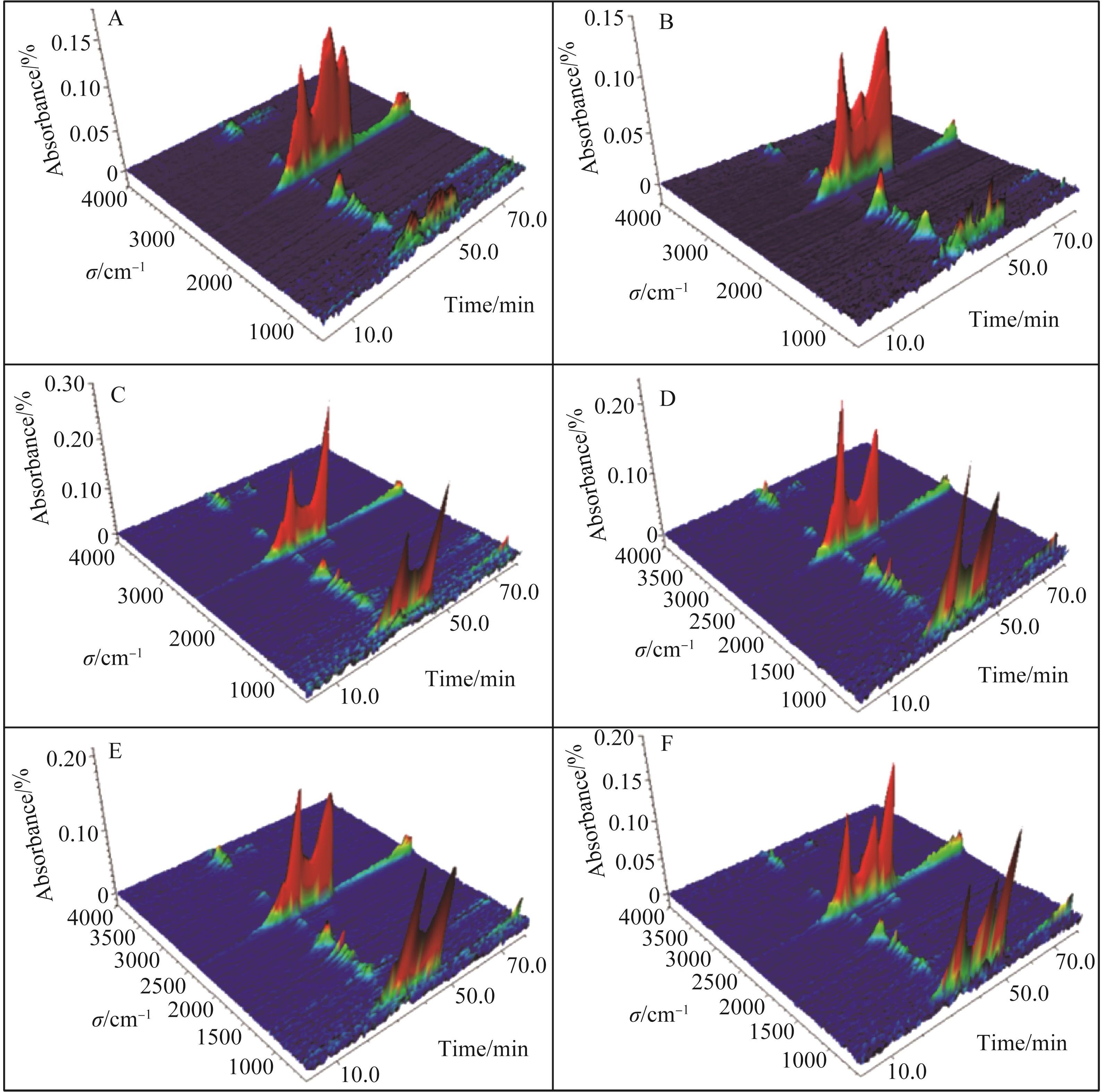
Fig.6 Three-dimensional FT-IR spectra of pyrolysis gas products of different plant fibers in O2/N2(V∶V=10∶100) atmosphere with heating rate of 10 K/min
| 1 | 石淑兰, 何福望. 制浆造纸分析与检测[M]. 北京: 中国轻工业出版社, 2003. |
| SHI S L, HE F W. Analysis and detection of pulp and papermaking[M]. Beijing: China Light Industry Press, 2003. | |
| 2 | 李桂珍, 龚安达, 刘润昌, 等. 非木材纤维在卷烟工业用纸中的应用[J]. 中国造纸, 2011, 30(5): 69-73. |
| LI G Z, GONG A D, LIU R C, et al. Application of non-wood fiber materials in the paper used in tobacco industry[J]. China Pulp Paper, 2011, 30(5): 69-73. | |
| 3 | 罗冲, 温洋兵, 李旺, 等. 造纸法烟草基片外加植物纤维的优化[J]. 中华纸业, 2013, 34(8): 6-10. |
| LUO C, WEN Y B, LI W, et al. Optimization on adding wood fiber in reconstituted tobacco sheet by papermaking process[J]. China Pulp Paper Ind, 2013, 34(8): 6-10. | |
| 4 | WANG S, RU B, LIN H, et al. Pyrolysis behaviors of four O-acetyl-preserved hemicelluloses isolated from hardwoods and softwoods[J]. Fuel, 2015, 150: 243-251. |
| 5 | WANG L, LI J, CHEN Y, et al. Investigation of the pyrolysis characteristics of guaiacol lignin using combined Py-GC×GC/TOF-MS and in‑situ FT-IR[J]. Fuel, 2019, 251: 496-505. |
| 6 | LU Q, ZHANG Z F, DONG C Q, et al. Catalytic upgrading of biomass fast pyrolysis vapors with nano metal oxides: an analytical Py-GC/MS study[J]. Energies, 2010, 3(11): 1805-1820. |
| 7 | LU Q, YANG X C, DONG C Q, et al. Influence of pyrolysis temperature and time on the cellulose fast pyrolysis products: analytical Py-GC/MS study[J]. J Anal Appl Pyrol, 2011, 92(2): 430-438. |
| 8 | OJHA D K, VINU R. Fast co-pyrolysis of cellulose and polypropylene using Py-GC/MS and Py-FT-IR[J]. RSC Adv, 2015, 5(82): 66861-66870. |
| 9 | PATWARDHAN P R, BROWN R C, SHANKS B H. Product distribution from the fast pyrolysis of hemicellulose[J]. ChemSusChem, 2011, 4(5): 636-643. |
| 10 | PISKORZ J, RADLEIN D, SCOTT D S. On the mechanism of the rapid pyrolysis of cellulose[J]. J Anal Appl Pyrol, 1986, 9(2): 121-137. |
| 11 | ZHOU X, LI W, MABON R, et al. A mechanistic model of fast pyrolysis of hemicellulose[J]. Energy Environ Sci, 2018, 11(5): 1240-1260. |
| 12 | ZHOU X, LI W, MABON R, et al. A critical review on hemicellulose pyrolysis[J]. Energy Technol, 2017, 5(1): 52-79. |
| 13 | JIANG L, WU N, ZHENG A, et al. Comprehensive utilization of hemicellulose and cellulose to release fermentable sugars from corncobs via acid hydrolysis and fast pyrolysis[J]. ACS Sustain Chem Eng, 2017, 5(6): 5208-5213. |
| 14 | LIN Y C, CHO J, TOMPSETT G A, et al. Kinetics and mechanism of cellulose pyrolysis[J]. J Phys Chem C, 2009, 113(46): 20097-20107. |
| 15 | PAINE J B, PITHAWALLA Y B, NAWORAL J D. Carbohydrate pyrolysis mechanisms from isotopic labeling: part 4. the pyrolysis of D-glucose: the formation of furans[J]. J Anal Appl Pyrol, 2008, 83(1): 37-63. |
| 16 | WANG S, RU B, LIN H, et al. Degradation mechanism of monosaccharides and xylan under pyrolytic conditions with theoretic modeling on the energy profiles[J]. Bioresource Technol, 2013, 143: 378-383. |
| 17 | MA Z, WANG J, YANG Y, et al. Comparison of the thermal degradation behaviors and kinetics of palm oil waste under nitrogen and air atmosphere in TGA-FT-IR with a complementary use of model-free and model-fitting approaches[J]. J Anal Appl Pyrol, 2018, 134: 12-24. |
| [1] | Jia-Zheng LI, Shu-Zhong HE. Research Progress of Total Synthesis of Polygalolides [J]. Chinese Journal of Applied Chemistry, 2023, 40(5): 615-624. |
| [2] | Wei-Yin XU, Tian-Yang XU, Si-Meng SHAO, Zhao-Yang XIE, Hong-Mei YANG, Peng YU. Research Progress of the Role of Chemical Active Components of Ginseng in Prevention and Treatment of Neurodegenerative Diseases [J]. Chinese Journal of Applied Chemistry, 2023, 40(4): 486-499. |
| [3] | Jun-Jie ZHANG, Yun-Jiao SHEN, Li-Ying MA, Peng-Hui WANG, Lei WANG, Yu-Lin DAI, Lei ZHAO. Study on Extract Composition of American Ginseng Flower in Oxidative-Induced H9c2 Cardromyocytes by LC-MS [J]. Chinese Journal of Applied Chemistry, 2023, 40(1): 126-133. |
| [4] | Yu-Hua XIONG, Lei ZHOU, Shi-Zhong YANG, Bo-Zhong MU. Enzymatic Properties and Gel Breaking Performance of Low-temperature β-Mannanase [J]. Chinese Journal of Applied Chemistry, 2023, 40(1): 134-145. |
| [5] | Xing-Yu WANG, Leng GAO, Liang-Chen QI, Xiao-Chen GAO, Lei DING, Yi-Tian QI, Ben-Hai CUI, Song-Yao YU, Hang LI. Study on Anti⁃Lung Cancer Active Ingredients from Blood of Xianghai Wild Goose Based on Network Pharmacology and Molecular Docking Technology [J]. Chinese Journal of Applied Chemistry, 2022, 39(11): 1680-1692. |
| [6] | Dong-Qing CAI, Jing ZHANG, Qing-Chuan WU, Jing-Hong YE, Lin-Ying WANG, Dong-Fang WANG. Preparation and Application of Attapulgite Based Nano⁃controlled Chlorpyrifos [J]. Chinese Journal of Applied Chemistry, 2022, 39(11): 1774-1782. |
| [7] | ZHAO Chang-Li, QIN Ming-Gao, DOU Xiao-Qiu, FENG Chuan-Liang. High Mechanical Stability and Osteogenesis of Chiral Supramolecular Hydrogel Induced by Inorganic Nanoparticles [J]. Chinese Journal of Applied Chemistry, 2022, 39(1): 177-187. |
| [8] | WU Qing-Lin, REN Yu-Bin, ZHAI Xiao-Wei, CHEN Dong, LIU Kai. Protein Sequence Design Using Generative Models [J]. Chinese Journal of Applied Chemistry, 2022, 39(1): 3-17. |
| [9] | HUAI Meng-Jiao, LIU Tao-Xue-Ting, JIANG Zhong-Yi. Research Progress of Artificial Water Channels Inspired by Aquaporin [J]. Chinese Journal of Applied Chemistry, 2022, 39(1): 99-109. |
| [10] | LI Ye-Hui, LI Xiao-Ning, HUI Wei, WANG Xiang, WANG Hai-Jun. Separation and Purification of Baicalin Using Deep Eutectic Solvent and Surfactant [J]. Chinese Journal of Applied Chemistry, 2021, 38(12): 1647-1654. |
| [11] | YANG Jia-Qiang,WU Xue-Jiao, ZHOU Xu-Rong, DENG Ling, YANG Hong. Synthesis and Antibacterial Activities of Osthole Ester Derivatives [J]. Chinese Journal of Applied Chemistry, 2021, 38(8): 917-922. |
| [12] | ZHANG Zhen-Hua, XIE Yu-Li, WANG Tie-Jun, ZHAO Hong, TANG Cun-Duo, KAN Yun-Chao, YAO Lun-Guang. Directed Evolution for Catalytic Activity of Formate Dehydrogenase and Its Overexpression [J]. Chinese Journal of Applied Chemistry, 2021, 38(6): 704-712. |
| [13] | GAO Song-Hong, YANG Di, LI Zhong-Qi, ZHENG Fei, JEON You-Jin, DAI Yu-Lin. Rapid Resolution Liquid Chromatography with Tandem Mass Spectrometry on Pharmacokinetics of Type 2 Diabetic Rats with Oral Administration of Sijunzitang Decoration [J]. Chinese Journal of Applied Chemistry, 2021, 38(3): 0-0. |
| [14] | ZHANG Na, LI Le-Le, HUANG Xin, LIU Shu-Ying. Determination of Oligosaccharides in Ginseng from Different Growth Environments by Ultra Performance Liquid Chromatography Triple Quadrupole Tandem Mass Spectrometry Combined with Solid Phase Methylation [J]. Chinese Journal of Applied Chemistry, 2021, 38(3): 247-255. |
| [15] | LI Le, TAN Lu-Ying, WANG Cai-Xia, LI Kun, LI Ping-Ya, LIU Jin-Ping, LIU Yun-He. Identification of Chemical Constituents of American Ginseng Fruit Pedicels by Ultra-performance Liquid Chromatography Quadrupole Time-of-Flight Mass Spectrometry [J]. Chinese Journal of Applied Chemistry, 2021, 38(3): 256-270. |
| Viewed | ||||||
|
Full text |
|
|||||
|
Abstract |
|
|||||
